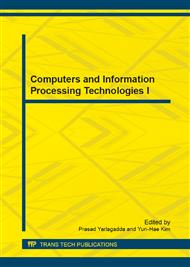[1]
J. Cadore,A. Gallardo-Antolín,C. Peláez-Moreno: Advances in Nonlinear Speech Processing Lecture Notes in Computer Science , 2011, Volume 7015, pp.224-231.
DOI: 10.1007/978-3-642-25020-0_29
Google Scholar
[2]
Cadore, J. Valverde-Albacete, F. J. Gallardo-Antolín, A. Peláez-Moreno, C. Auditory-Inspired Morphological Processing of Speech Spectrograms: Applications in Automatic Speech Recognition and Speech Enhancement. Cognitive Computation, 2012, 1-16.
DOI: 10.1007/s12559-012-9196-6
Google Scholar
[3]
Cadore, J. Gallardo-Antolín, A. Peláez-Moreno, C. Morphological processing of spectrograms for speech enhancement. 2011, 7015 LNAI, 224-231.
DOI: 10.1007/978-3-642-25020-0_29
Google Scholar
[4]
Ariki Y, Kato S, and Takiguchi T. phoneme Recognition Based on Fisher Weight Map to Higher-Order Local Auto-Correlation, Proc. of Interspeech, 2006, 377-380.
DOI: 10.21437/interspeech.2006-126
Google Scholar
[5]
S. Raphael O.S. Douglas: Segmentation of a Speech Spectrogram using Mathematical Morphology[J]. Proceeding of IEEE ICASSP, 2008, 1637-1640.
Google Scholar
[6]
Yin, H. Nadeu, C. Hohmann, V. Pitch- and formant-based order adaptation of the fractional fourier transform and its application to speech recognition. Eurasip Journal on Audio, Speech, and Music Processing. (2009).
DOI: 10.1155/2009/304579
Google Scholar
[7]
Cao, J. Li, A. Hu, F. Zhang, L. Application of phonetic knowledge in automatic speech recognition - Case analysis. Qinghua Daxue Xuebao/Journal of Tsinghua University, 2008, 48, SUPPL, 748-753.
Google Scholar
[8]
Serra J. Image analysis and mathematical morphology[C]. London: Academic Press, 1982, 115.
Google Scholar
[9]
Mellinger, D. K. Clark, C. W. Recognizing transient low-frequency whale sounds by spectrogram correlation. Journal of the Acoustical Society of America. 2000, 107, 6, 3518-3529.
DOI: 10.1121/1.429434
Google Scholar
[10]
Ashish B. Ingale, D. S. Chaudhari. Speech Emotion Recognition. International Journal of Soft Computing and Engineering . March 2012 , Volume-2, Issue-1.
Google Scholar
[11]
Shinha D and Dougherty E R. Fuzzy mathematical morphology[J]. J Vision, Communication and Imagine and Representation, 1992, 3( 3): 286-302.
Google Scholar
[12]
Evangelista G. Pitch-Synchronous Wavelet Representations of Speech and Music Signal. IEEE. Trans on 1993, 41(12): 3313-3330.
DOI: 10.1109/78.258076
Google Scholar
[13]
Nwe, Tin Lay. Foo, Say Wei. De Silva, Liyanage C. Speech emotion recognition using hidden Markov models. Speech Communication. 2003, 41, 4, 603-623.
DOI: 10.1016/s0167-6393(03)00099-2
Google Scholar
[14]
Schuller B. Rigoll G. Lang M. Hidden Markov model-based speech emotion recognition. 2003 April, II - 1-4 vol. 2.
DOI: 10.1109/icassp.2003.1202279
Google Scholar
[15]
Hunt, Melvyn J. Lefebvre, Claude. Speech recongnition using an auditory model with pitch-synchronous analysis. Proceedings - ICASSP, IEEE International Conference on Acoustics, Speech and Signal Processing. 1987, 813-816.
DOI: 10.1109/icassp.1987.1169585
Google Scholar
[16]
Lam L, Suen C Y. An evaluation of parallel thinning algorithms for character recognition[J]. IEEE Trans on Pattern Analysis and Machine Intelligence, 1995, 17(9): 914-919.
DOI: 10.1109/34.406659
Google Scholar
[17]
Gasteratos A, Tsalides S. Fuzzy soft mathematical morphology[J]. Image Signal Processing, 1998, 145(1): 41- 49.
DOI: 10.1049/ip-vis:19981557
Google Scholar
[18]
Chen Sin-Homg, Senior Member, and Wang Yih-Ru. Tone Recognition of Continuous Mandarin Speech Based on Neural Networks[J]. IEEE Transactions on Speech and Audio Processing, 1995, 3(2): 146-150.
DOI: 10.1109/89.366544
Google Scholar
[19]
Yang W J. Hidden Markov Model for Mandarin lexical tone recognition, IEEE Trans. Acoust Speech Signal Process, 1988, 36: 988-992.
DOI: 10.1109/29.1620
Google Scholar
[20]
Chennonkh S, Gerrits A, Miet G, et al. Speech Enhancement via Frequency Extension using Spectral Frequency[A]. Proc. ICASSP[C]. SaltLakeCity, 2001, 5.
Google Scholar
[21]
Rea J A, Longbotham H G, Kothari H.N. Fuzzy Logic Mathematical Morphology: implementation by Stack Filter. IEEE Trans. on Signal Processing, 1996, 44(l): 142-147.
DOI: 10.1109/78.482024
Google Scholar
[22]
Blum H. A Transformation for Extracting New Descriptors of Shape, Models for the Perception of Speech and Visual Forms,W. Watheen Dunn, Ed. Cambridge, MA: MIT Press, (1967).
Google Scholar


